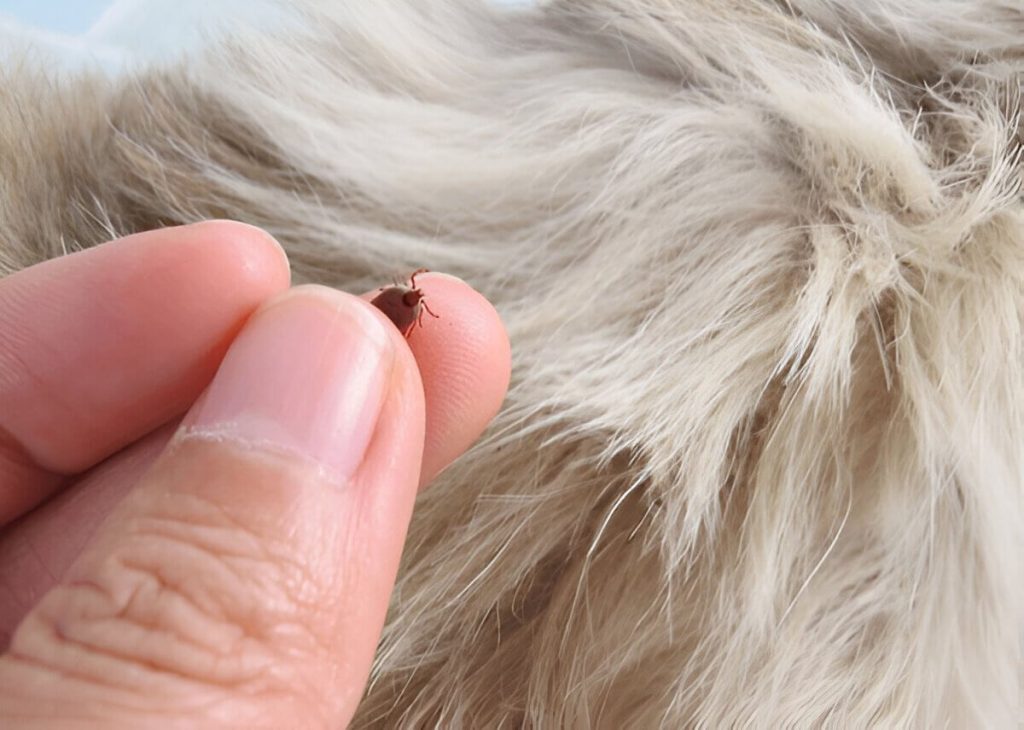Mites are microscopic arthropods that belong to the same family as spiders and ticks. They are nearly invisible to the naked eye, yet they can have a significant impact on the health and comfort of dogs. These tiny creatures thrive in various environments and can easily find their way onto your pet, leading to a range of skin issues.
Mites on dogs can manifest in several forms, each causing distinct problems. Dog skin mites, such as Demodex or Sarcoptes scabiei, are notorious for causing conditions like mangea, which is a severe skin disease characterized by itching, hair loss, and inflammation. Canine mites often burrow into the skin or hair follicles of dogs, leading to irritation and discomfort.
Understanding what mites are is crucial for dog owners because early detection and treatment can prevent more serious health issues from developing. By recognizing the signs of mite infestations (such as excessive scratching or visible patches of hair loss) you can take swift action to address these unwelcome visitors before they lead to more complicated dermatological problems for your furry friend.
Types of Mites Found on Dogs and Their Symptoms
When it comes to our furry friends, understanding the different types of mites that can affect them is crucial for maintaining their health and comfort. Mites are tiny parasites that can cause a range of skin issues in dogs, and knowing how to identify their symptoms can help ensure timely treatment.
One common type is sarcoptic mange, also known as canine scabies. This condition is caused by Sarcoptes scabiei mites, which burrow into the dog’s skin, leading to intense itching and discomfort. Symptoms typically include redness, hair loss, and crusty skin lesions. It’s highly contagious among dogs and requires prompt veterinary care.
Another type is demodex mites, which naturally reside in small numbers on a dog’s skin without causing harm. However, an overgrowth can lead to demodectic mange or demodicosis. This condition often results in patchy hair loss and mild itching but isn’t usually itchy unless secondary infections occur.
Lastly, ear mites are another common concern for dog owners. These tiny parasites live in the ear canal and cause symptoms such as head shaking, scratching at the ears, dark discharge, and an unpleasant odor from the ears.
Understanding these types of dog mites and their symptoms can help you take swift action to alleviate your pet’s discomfort and prevent further complications. If you notice any signs of mite infestations on your dog, consulting with a veterinarian for accurate diagnosis and treatment options is essential.
How to Identify a Mite Infestation in Your Dog

Identifying a mite infestation in your dog early can prevent discomfort and more serious health issues. Mites are microscopic parasites that can cause significant irritation and lead to skin infections if left untreated. Understanding the dog mite symptoms is crucial for timely intervention.
One of the first signs of a mite infestation is excessive scratching or biting at the skin, as mites cause intense itching. You may also notice redness, inflammation, or visible sores on your dog’s skin, which are common dog skin infection signs associated with mites. Hair loss in patches or a dull coat may also indicate an issue.
To diagnose mite infestation in dogs accurately, it’s important to observe any behavioral changes such as increased restlessness or irritability due to discomfort. A visit to the veterinarian is essential for proper diagnosis and treatment. They will likely perform a skin scrape test to identify the presence of mites under a microscope.
By staying vigilant about these symptoms and seeking prompt veterinary care, you can ensure your furry friend remains healthy and comfortable.
Treatment Options for Dogs with Mite Infestations
When it comes to treating mite infestations in dogs, there are several options available that can effectively alleviate the discomfort and restore your pet’s health. Mite treatment for dogs can range from home remedies to professional veterinary interventions, depending on the severity of the infestation.
For those looking into mange treatment for dogs at home, there are a few natural remedies that might help manage mild cases. Regular bathing with medicated shampoos designed to soothe irritated skin and remove mites is a common approach. Additionally, applying diluted apple cider vinegar can create an inhospitable environment for mites due to its acidity. However, it’s crucial to consult with a veterinarian before trying any home treatments to ensure they are safe and appropriate for your dog’s specific condition.
In more severe cases or when home remedies prove ineffective, veterinary mite treatments become necessary. Veterinarians may prescribe topical medications or oral drugs specifically formulated to eradicate mites and heal affected skin. These treatments often include antiparasitic medications such as ivermectin or selamectin, which have proven efficacy in clearing infestations.
While some mild mite infestations might be managed at home with careful attention and natural remedies, professional veterinary care ensures comprehensive treatment tailored to your dog’s needs. Always seek advice from a veterinarian if you suspect your dog has a mite infestation for an accurate diagnosis and effective treatment plan.
Preventing Future Mite Infestations on Your Dog
Preventing future mite infestations on your dog involves a proactive approach to their hygiene and health care routine. One of the key strategies in preventing dog mites is maintaining a consistent grooming schedule. Regular bathing with appropriate pet shampoos can help keep your dog’s skin clean and less attractive to mites. Additionally, brushing your dog’s coat regularly not only helps in spotting early signs of an infestation but also promotes healthy skin and fur.
Incorporating dog hygiene tips for mite prevention into your routine is essential. Ensure that your dog’s living environment is clean; this includes washing their bedding frequently and vacuuming areas where they spend most of their time. Keeping these spaces free from dust and debris can significantly reduce the risk of mites setting up residence.
Regular check-ups for pets are another crucial component in preventing mite infestations. Routine veterinary visits allow for early detection of any potential issues, including mites, ensuring prompt treatment before they become a larger problem. Your vet can also provide additional advice tailored to your dog’s specific needs, helping you maintain a comprehensive prevention strategy against mites and other parasites. By combining good hygiene practices with regular professional check-ups, you can effectively protect your furry friend from uncomfortable mite infestations in the future.
The Importance of Consulting a Veterinarian for Proper Diagnosis and Treatment
When it comes to your furry friend’s health, seeking a veterinary consultation for dog mites is crucial for ensuring their well-being. Mites can cause severe discomfort and lead to more serious skin conditions if left untreated. While it might be tempting to try over-the-counter remedies or home treatments, only a professional diagnosis of canine skin issues can accurately identify the specific type of mite affecting your pet.
Veterinarians have the expertise and tools necessary to conduct thorough examinations and tests, providing a precise diagnosis that guides effective treatment plans. They can differentiate between various types of mites, such as Demodex or Sarcoptes, each requiring distinct approaches for eradication. Moreover, veterinarians consider the overall health of your dog when prescribing treatments, ensuring that any underlying conditions are also addressed.
By consulting a veterinarian promptly, you not only alleviate your dog’s immediate discomfort but also prevent potential complications that could arise from untreated mite infestations. Trusting in professional care guarantees that your beloved pet receives the best possible attention tailored specifically to their needs.
Conclusion- Maintaining Your Dog’s Health by Recognizing and Managing Mite Problems Early
Maintaining your dog’s health involves vigilance and proactive care, particularly when it comes to managing mite infestations. Recognizing the early signs of mite problems can make a significant difference in your pet’s well-being. Mites, though microscopic, can cause discomfort and lead to more severe health issues if left untreated.
Regularly inspect your dog’s skin and coat for any signs of irritation, such as excessive scratching, redness, or hair loss. These symptoms often indicate the presence of mites and should prompt a visit to the veterinarian for a proper diagnosis. Early detection allows for more effective treatment options that can alleviate discomfort and prevent further complications.
Implementing a consistent grooming routine is another crucial step in maintaining your dog’s health. Regular baths using vet-recommended shampoos can help keep mites at bay by removing dirt and debris that may harbor these parasites. Additionally, maintaining a clean living environment by regularly washing bedding and vacuuming carpets reduces the risk of mite infestations.
Incorporating preventive measures into your pet care routine not only protects against mites but also contributes to overall better health for your dog. A balanced diet, regular exercise, and routine veterinary check-ups are essential components of comprehensive pet care that support a strong immune system capable of resisting parasitic threats.
By staying informed about potential mite issues and taking proactive steps in prevention and management, you ensure that your furry friend enjoys a healthier life free from the discomfort caused by these pesky parasites.
